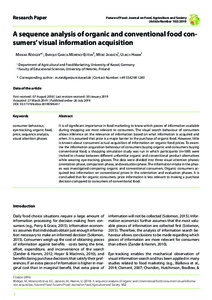Aufsatz

A sequence analysis of organic and conventional food consumers’ visual information acquisition
Zusammenfassung
It is of significant importance in food marketing to know which pieces of information available during shopping are most relevant to consumers. The visual search behaviour of consumers allows inference on the relevance of information based on what information is acquired and when. It is assumed that price is a major barrier to the purchase of organic food. However, little is known about consumers’ actual acquisition of information on organic food prices. To examine the information acquisition behaviour of consumers buying organic and consumers buying conventional food, a shopping simulation study was run in which participants (n=189) were invited to choose between different unfamiliar organic and conventional product alternatives while wearing eye-tracking glasses. The data were divided into three visual attention phases: orientation phase, comparison phase, and evaluation phase. The information intake in the phases was investigated comparing organic and conventional consumers. Organic consumers acquired less information on conventional prices in the orientation and evaluation phases. It is concluded that for organic consumers, price information is less relevant to making a purchase decision compared to consumers of conventional food.
Zitierform
In: Future of Food: Journal on Food, Agriculture & Society Volume 7 / No 2 (2019-07-26) , S. Article Number 102 ; ISSN 2197-411XSammlung(en)
Vol 07, No 2 (2019) (Future of Food: Journal on Food, Agriculture & Society // The Future of Food Journal: Journal on Food, Agriculture & Society)Zitieren
@article{doi:10.17170/kobra-20190506417,
author={Rödiger, Manika Sarah and Garcia Moreno-Esteva, Enrique and Janssen, Meike and Hamm, Ulrich},
title={A sequence analysis of organic and conventional food consumers’ visual information acquisition},
journal={Future of Food: Journal on Food, Agriculture & Society},
year={2019}
}
0500 Oax 0501 Text $btxt$2rdacontent 0502 Computermedien $bc$2rdacarrier 1100 2019$n2019 1500 1/eng 2050 ##0##http://hdl.handle.net/123456789/11417 3000 Rödiger, Manika Sarah 3010 Garcia Moreno-Esteva, Enrique 3010 Janssen, Meike 3010 Hamm, Ulrich 4000 A sequence analysis of organic and conventional food consumers’ visual information acquisition / Rödiger, Manika Sarah 4030 4060 Online-Ressource 4085 ##0##=u http://nbn-resolving.de/http://hdl.handle.net/123456789/11417=x R 4204 \$dAufsatz 4170 7136 ##0##http://hdl.handle.net/123456789/11417
<resource xsi:schemaLocation="http://datacite.org/schema/kernel-2.2 http://schema.datacite.org/meta/kernel-2.2/metadata.xsd"> 2020-01-14T10:29:06Z 2020-01-14T10:29:06Z 2019-07-26 doi:10.17170/kobra-20190506417 http://hdl.handle.net/123456789/11417 eng Section Specialized Partnerships in Sustainable Food Systems and Food Sovereignty at the University of Kassel, Germany and Federation of German Scientists (VDW) Urheberrechtlich geschützt https://rightsstatements.org/page/InC/1.0/ consumer behaviour eye-tracking organic food price sequence analysis visual attention phases 630 A sequence analysis of organic and conventional food consumers’ visual information acquisition Aufsatz It is of significant importance in food marketing to know which pieces of information available during shopping are most relevant to consumers. The visual search behaviour of consumers allows inference on the relevance of information based on what information is acquired and when. It is assumed that price is a major barrier to the purchase of organic food. However, little is known about consumers’ actual acquisition of information on organic food prices. To examine the information acquisition behaviour of consumers buying organic and consumers buying conventional food, a shopping simulation study was run in which participants (n=189) were invited to choose between different unfamiliar organic and conventional product alternatives while wearing eye-tracking glasses. The data were divided into three visual attention phases: orientation phase, comparison phase, and evaluation phase. The information intake in the phases was investigated comparing organic and conventional consumers. Organic consumers acquired less information on conventional prices in the orientation and evaluation phases. It is concluded that for organic consumers, price information is less relevant to making a purchase decision compared to consumers of conventional food. open access Rödiger, Manika Sarah Garcia Moreno-Esteva, Enrique Janssen, Meike Hamm, Ulrich publishedVersion ISSN 2197-411X No 2 Future of Food: Journal on Food, Agriculture & Society Article Number 102 Volume 7 </resource>
Die folgenden Lizenzbestimmungen sind mit dieser Ressource verbunden:
Urheberrechtlich geschützt

